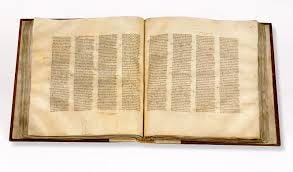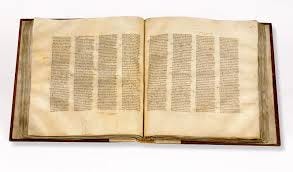It has been a while since I’ve done anything in my “6 Things” series, but I thought I’d return to it focusing on the Septuagint.
For those who don’t know, the Septuagint is the Greek Translation of the Old Testament from the original Hebrew Bible (HB). According to legend/convention/history, the translation of the Torah was done in Egypt in the third century by “72” translators, hence the name “Septuagint,” which is is abbreviated as “LXX” from the Roman numeral for the number 70.
Here are the interesting facts you should know about the LXX!
1. There was no official LXX in Judaism or the early church. While there might well have been an effort to translate the Hebrew Torah into Greek with Ptolemaic patronage in third-century Alexandria, there was no standard Greek text of the OT. That is because Greek translations of the OT became increasingly common among Jewish communities of the eastern Mediterranean where Greek was the lingua franca. But there was no “control” over the translations. Some of these translations were literal, others were paraphrastic, and some were even speculative when the Greek translator was simply guessing what a Hebrew word meant (esp. for animals, musical instruments, and people’s names). What emerged was a number of Greek translations of Hebrew Books which we call the OG or “Old Greek.” There is a fascinating Greek translation of the Twelve Minor Prophets from the first century as part of the Nahal Hever collection. Christians eventually became the main consumers and users of the LXX and had a propensity to Christianize it to suit their theological interests. It is hardly surprising then that the primary textual witnesses to the LXX are the fourth and fifth-century codices Codex Vaticanus, Codex Sinaiticus, and Codex Alexandrinus. Later, several attempts were made to revise the Greek text and bring it closer to the original Hebrew while also trying to resist “Christianizations” of the Greek text by some Jewish translators (i.e. Theodotian, Symmachus, and Aquila).
2. The LXX contains books not found in the HB. The LXX was not a recognized “collection” or a “canon” in its own right. An earlier generation of scholars used to talk about an “Alexandrian Canon” as if Egyptian Jews had a “canon” larger and more fluid than the HB, but such a view is not really held anymore. That said, a number of Jewish books not found in the HB are found in the LXX. Some of these had a Hebrew original (e.g., Tobit, Ben Sira, and probably 1 Esdras), but others were composed in Greek and never had a Hebrew original (e.g., Wisdom of Solomon). These extra books form the basis of what is called the “Apocrypha.”
3. The primary edition of the LXX used today is Rahlfs-Hanhart. The Rahlfs-Hanhart edition is an eclectic text that is put together by weighing up several different textual witnesses from Christian codices and the OG. I also learned, from my time working on 1 Esdras, that Rahlfs-Hanhart contains a lot of conjectural emendations, i.e, the scholars sometimes offer a Greek translation of the Hebrew that is not found in any manuscript because in their mind it makes for a better translation of the Hebrew!
To read further, consider joining the “Aviary” by taking out a paid subscription, only $7 per month or $75 per year, supports me in my ministry and scholarship, and gets you 4-5 posts per week on biblical studies, Christianity and gender relationships, cultural commentary, book reviews, previews of my forthcoming books, and some cool videos.
4. NT authors usually quote the OT from the LXX and not from the HB. The majority of references to the OT in Paul’s letters and Hebrews are from Greek translations of the OT (i.e., LXX). This alone means that it cannot be ignored or glossed over. The LXX was the Bible of the apostles, the early church, and it was only with the popularity of Jerome’s Vulgate that the LXX was eclipsed in the western church.
5. Sometimes the NT authors make points that depend on the precise LXX rendering which can be different from the OT. Let me give two examples. First, in Romans 4, Paul employs a midrashic interpretive technique by combining two passages together, Gen 15:6 and Ps 32:2, based on a common word these two passages share: the word logizomai (“to credit”). However – and here’s the thing – they only have a common word in the Greek and not in the Hebrew. Thus, the LXX provided a hermeneutical possibility that would not have been available if Paul had used a Hebrew version of the text. In that sense, it is the LXX and not the HB that shaped Paul’s precise argument about justification by faith. Second, a comparison of Amos 9:11-15 reveals some serious differences between the LXX and HB. The HB has Israel conquering Edom in v. 12, but the LXX has the Gentiles seeking out after God. What is more, James in Acts 15:15-18 quotes the LXX version not the HB version to justify the inclusion of Gentiles in the church!
6. There are some mind-boggling textual issues when we juxtapose the HB and the LXX. For example, concerning the Book of Jeremiah, the received Hebrew text of Jeremiah is based on the twelfth-century Masoretic text (MT), yet the Septuagintal version of Jeremiah (LXX), is based on an underlying Hebrew Vorlage which is 2700 words or one-eighth shorter than MT Jeremiah. To make it even more complicated, textual fragments from the Dead Sea Scrolls offer support for LXX Jeremiah against MT Jeremiah in some instances and support for MT Jeremiah against LXX Jeremiah in other instances! It is probable that two different editions of Jeremiah were in circulation and are expressed in the LXX and MT. Textual scholars normally maintain that shorter readings are likely to be the more original, since the tendency of scribes was to add rather than excise texts. In which case, LXX Jeremiah and its underlying Hebrew Vorlage would have a better case to represent an original autograph. However, our critical editions of the Hebrew Bible and our English Bibles are based on the longer MT Jeremiah on the grounds that it represents not an original autograph but an original edition! So, when you’re reading the Book of Jeremiah in your NIV or ESV, you’re not reading a copy of the autograph, you’re either reading an inspired edition, or reading an inspired linear development from an autograph.
Further Reading
Jobes, Karen H., and Moises Silva. Invitation to the Septuagint. Grand Rapids, MI: Baker Academic, 2000.
Law, T. Michael. When God Spoke Greek: The Septuagint and the Making of the Christian Bible. Oxford: Oxford University Press, 2013.
Pietersma, Albert, and Benjamin G. Wright, eds. A New English Translation of the Septuagint. Oxford: Oxford University Press, 2007.
Rahlfs, Alfred, and Robert Hanhart, eds. Septuaginta: Editio Altera. Stuttgart: Deutsche Bibelgesellschaft, 2006.





What do the inerrantists make of all this? Or does inerrancy, in practice, apply only to the New Testament?
I enjoyed this so much! Especially points 4 and 5. Very instructive and new material from what I was taught decades ago.